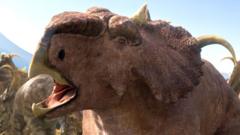In the heart of Alberta, Canada, a colossal mass grave lies hidden beneath the verdant forest—a grave that holds the remains of thousands of dinosaurs, all meeting a tragic fate in an instant. This site, known as Pipestone Creek or the "River of Death," has beckoned palaeontologists who aim to uncover the details of this unprecedented event that occurred 72 million years ago.
To begin their investigation, Professor Emily Bamforth, leading the excavation team, skillfully strikes the hard rock using a sledgehammer—an initial step to expose what she calls "palaeo gold." As layers of sediment are cleared, a variety of fossilized bones become visible. “That large structure is likely a hip bone," Prof Bamforth explains, while her attentive dog, Aster, keeps watch for any wildlife.
The discoveries at Pipestone Creek primarily revolve around the Pachyrhinosaurus species, featured in a new BBC series "Walking With Dinosaurs," combining educational content with groundbreaking visual effects. These dinosaurs were significant creatures of the Late Cretaceous period, boasting a unique ridge atop their heads, coupled with their three notable horns. The excavation process unfolds across an area comparable to a tennis court, yet preliminary estimates suggest the expansive burial ground stretches over a kilometer into the hillside, with about 300 bones per square meter.
As the excavation progresses, scientists hypothesize the Pachyrhinosaurus were part of a vast migrating herd moving northward from their winter territory. The area they traversed was once rich in vegetation, providing sustenance for these massive plant-eaters. "This scenario presents us with a rare snapshot of a single species from prehistoric times," elucidates Prof Bamforth.
Journeying farther from Pipestone Creek, the team also explores the nearby Deadfall Hills—a site where even larger dinosaur remains can be found, washed out from the rock by fast-moving waters. Here, the presence of Edmontosaurus bones adds to their understanding of the ecosystem they inhabited.
Through rigorous research, palaeontologists work tirelessly to piece together how thousands of these dinosaurs perished. The prevailing theory points to a natural disaster, likely a sudden flash flood resulting from a storm that uprooted trees and carried away boulders. As Prof Bamforth notes, the Pachyrhinosaurus were ill-equipped to escape the impending chaos.
Rocks at the site bear witness to this catastrophic culprits, captured in time, indicating the swirling sediment from the rushing water. For palaeontologists, every digging season promises fresh discoveries about these creatures. “Each visit here guarantees new findings," shares Prof Bamforth enthusiastically.
As excavators pack their tools and plan future returns, the rich history of Pipestone Creek remains largely unexplored, with countless insights into the ancient world still hidden in its depths. Tune into "Walking With Dinosaurs," premiering Sunday, May 25, to witness the ongoing exploration of this fascinating chapter in Earth's history.
To begin their investigation, Professor Emily Bamforth, leading the excavation team, skillfully strikes the hard rock using a sledgehammer—an initial step to expose what she calls "palaeo gold." As layers of sediment are cleared, a variety of fossilized bones become visible. “That large structure is likely a hip bone," Prof Bamforth explains, while her attentive dog, Aster, keeps watch for any wildlife.
The discoveries at Pipestone Creek primarily revolve around the Pachyrhinosaurus species, featured in a new BBC series "Walking With Dinosaurs," combining educational content with groundbreaking visual effects. These dinosaurs were significant creatures of the Late Cretaceous period, boasting a unique ridge atop their heads, coupled with their three notable horns. The excavation process unfolds across an area comparable to a tennis court, yet preliminary estimates suggest the expansive burial ground stretches over a kilometer into the hillside, with about 300 bones per square meter.
As the excavation progresses, scientists hypothesize the Pachyrhinosaurus were part of a vast migrating herd moving northward from their winter territory. The area they traversed was once rich in vegetation, providing sustenance for these massive plant-eaters. "This scenario presents us with a rare snapshot of a single species from prehistoric times," elucidates Prof Bamforth.
Journeying farther from Pipestone Creek, the team also explores the nearby Deadfall Hills—a site where even larger dinosaur remains can be found, washed out from the rock by fast-moving waters. Here, the presence of Edmontosaurus bones adds to their understanding of the ecosystem they inhabited.
Through rigorous research, palaeontologists work tirelessly to piece together how thousands of these dinosaurs perished. The prevailing theory points to a natural disaster, likely a sudden flash flood resulting from a storm that uprooted trees and carried away boulders. As Prof Bamforth notes, the Pachyrhinosaurus were ill-equipped to escape the impending chaos.
Rocks at the site bear witness to this catastrophic culprits, captured in time, indicating the swirling sediment from the rushing water. For palaeontologists, every digging season promises fresh discoveries about these creatures. “Each visit here guarantees new findings," shares Prof Bamforth enthusiastically.
As excavators pack their tools and plan future returns, the rich history of Pipestone Creek remains largely unexplored, with countless insights into the ancient world still hidden in its depths. Tune into "Walking With Dinosaurs," premiering Sunday, May 25, to witness the ongoing exploration of this fascinating chapter in Earth's history.



















